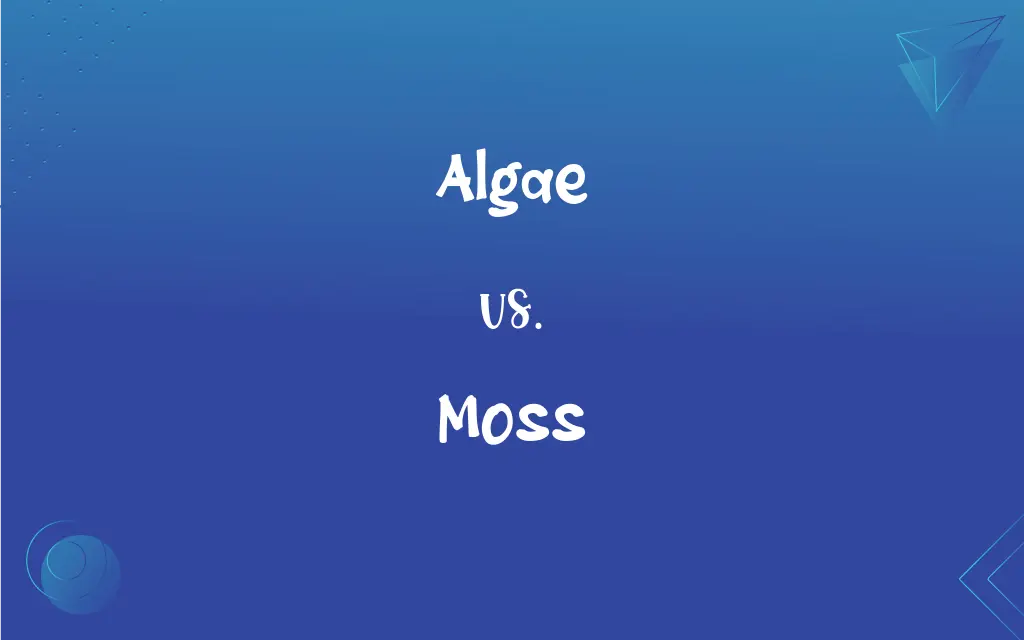Algae vs. Moss: What's the Difference?
Edited by Janet White || By Harlon Moss || Updated on July 1, 2024
Algae are simple, autotrophic organisms often found in water, while mosses are non-vascular plants that grow in dense green clumps or mats, mainly on moist lands.

Key Differences
Algae signify a diverse group of photosynthetic organisms that can inhabit various environments, such as freshwater, seawater, and even moist stones. Moss, however, symbolizes small, non-vascular plants that typically form dense green mats on rocks, soil, and damp surfaces.
Algae, in its entity, can be unicellular or multicellular, showcasing the diversity in their physical structures and habitat adaptations. Moss, on the opposite spectrum, unequivocally projects itself as a multicellular organism, often embracing a compact and cushy appearance in terrestrial habitats.
Algae contribute significantly to aquatic ecosystems, serving as a fundamental food source for various organisms and playing a vital role in oxygen production. Conversely, moss establishes its significance on land, aiding in preventing soil erosion and serving as a moisture buffer in various ecosystems.
The reproductive strategy in algae involves both sexual and asexual reproduction, with some species demonstrating a fascinating alternation of generations. Moss engages in a distinctive reproductive mechanism, primarily through spores, yet it too shows an intriguing alternation of generations.
In the realm of utility, algae find its use in industries like biofuel production and as a component in some food and skincare products. Moss, with its soft and absorbent nature, finds applications in gardening (as a soil conditioner) and in certain traditional medicinal practices.
ADVERTISEMENT
Comparison Chart
Basic Structure
Can be unicellular or multicellular
Always multicellular
Habitat
Primarily aquatic, both fresh and saltwater
Mainly terrestrial, prefers damp areas
Reproduction
Both sexual and asexual
Primarily through spores
Physical Appearance
Can be slimy or powdery
Appears as a dense, green, cushy mat
Economic Utility
Used in biofuel, food, and cosmetics
Used in gardening and traditional medicine
ADVERTISEMENT
Algae and Moss Definitions
Algae
Algae are primarily aquatic, photosynthetic organisms.
The pond is teeming with algae, tinting the water a deep green.
Moss
Moss contributes to its ecosystem by helping prevent soil erosion and retaining moisture.
Moss clung to the soil, preventing it from being washed away during the rainfall.
Algae
Algae serve as crucial oxygen producers in ecosystems.
Algae, through photosynthesis, contribute substantially to the world's oxygen supply.
Moss
Moss reproduces through spores, released from specialized structures called sporangia.
When it's time to reproduce, the moss releases tiny spores into the air.
Algae
Algae play a fundamental role in aquatic food chains.
Small fish and various microorganisms rely on algae as a primary food source.
Moss
Moss lacks true roots, instead having rhizoids that anchor it to surfaces and aid in nutrient absorption.
The moss used its delicate rhizoids to grip onto the rugged rock.
Algae
Algae can be utilized in producing biofuels.
Researchers are exploring efficient methods to harness algae for sustainable biofuel production.
Moss
Moss is a small, green, non-vascular plant that forms dense carpets in moist environments.
Moss covered the forest floor, providing a soft bed for wandering animals.
Algae
Algae find applications in culinary uses, particularly in Asian cuisines.
Algae, in the form of seaweed, is a staple ingredient in sushi preparation.
Moss
Moss often serves as an indicator of air quality and moisture availability in a given area.
The presence of moss on trees indicated a high level of moisture in the area.
Algae
Any of numerous photosynthetic organisms of aquatic or moist habitats, ranging in size from single-celled diatoms to large seaweeds such as kelp, and characterized by a lack of complex organs and tissues. Once classified within the plant kingdom, the algae are now considered to include several unrelated groups belonging to different kingdoms.
Moss
Any of various green, usually small, nonvascular plants of the division Bryophyta, having leaflike structures arranged around the stem and spores borne in a capsule.
Algae
Algal organisms viewed collectively or as a mass; algal growth.
Algae
(countable) A particular kind of algae.
Algae
Plural of alga.
Algae
Primitive chlorophyll-containing mainly aquatic eukaryotic organisms lacking true stems and roots and leaves
FAQs
Can algae live outside of water?
Some algae species can survive in moist environments outside of water.
Is algae a plant?
Algae is not classified as plants, although they perform photosynthesis.
Does moss have roots?
Moss does not have true roots but has rhizoids to anchor itself and absorb nutrients.
Where can moss be commonly found?
Moss is typically found in damp, shaded terrestrial environments.
How does moss absorb water?
Moss absorbs water directly through its leaves.
Is algae a single species?
No, algae encompass a vast group with numerous species.
What is algae?
Algae are simple, often aquatic organisms capable of photosynthesis.
Are all algae green?
No, algae come in various colors, including green, red, and brown.
Are algae found in both fresh and saltwater environments?
Yes, algae can be found in both fresh and saltwater ecosystems.
Can moss survive in dry conditions?
Moss can survive periods of dryness but thrives in moist conditions.
Is moss used for any commercial purposes?
Yes, moss is used in gardening, decoration, and some traditional medicines.
Can I eat algae?
Yes, certain algae like seaweed are edible and nutritious.
Can moss grow indoors?
Yes, moss can grow indoors in humid conditions and with sufficient light.
How do algae contribute to the ecosystem?
Algae produce oxygen and serve as a food source in aquatic ecosystems.
Can algae be used in biofuel production?
Yes, algae are being researched and utilized in biofuel production.
How does moss reproduce?
Moss reproduces primarily through the dispersal of spores.
Can algae be harmful?
Some algae produce toxins, creating harmful algal blooms.
Does moss provide any benefits to the environment?
Yes, moss prevents soil erosion and provides habitat for various organisms.
Is moss capable of photosynthesis?
Yes, moss performs photosynthesis using its small, green leaves.
Why does moss grow on trees?
Moss grows on trees to access light, but it does not harm the tree.
About Author
Written by
Harlon MossHarlon is a seasoned quality moderator and accomplished content writer for Difference Wiki. An alumnus of the prestigious University of California, he earned his degree in Computer Science. Leveraging his academic background, Harlon brings a meticulous and informed perspective to his work, ensuring content accuracy and excellence.
Edited by
Janet WhiteJanet White has been an esteemed writer and blogger for Difference Wiki. Holding a Master's degree in Science and Medical Journalism from the prestigious Boston University, she has consistently demonstrated her expertise and passion for her field. When she's not immersed in her work, Janet relishes her time exercising, delving into a good book, and cherishing moments with friends and family.































































